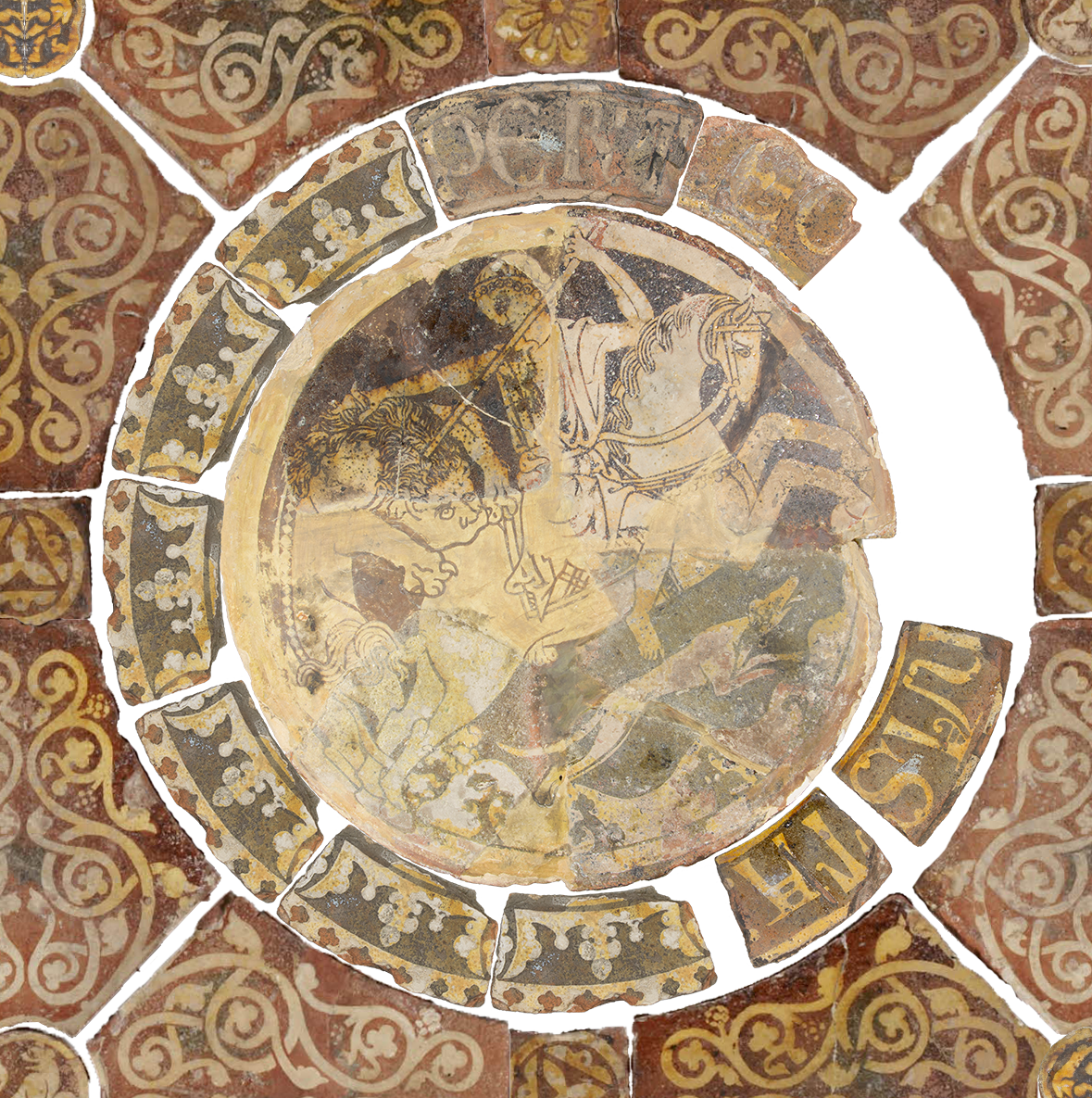
Art historians have recreated part of the interior of London’s long-lost medieval royal palace.
Most of the vast palace complex - one of the largest in medieval England - was destroyed by fire more than five centuries ago.
Today the only major surviving palace building is Westminster Hall which still forms part of the Houses of Parliament.
But new research by an American art historian has, for the first time, discovered what a key part of the medieval palace’s impressive internal décor would have looked like.
Medieval art investigator, Amanda Luyster, has managed to digitally reassemble most of a mosaic pavement design, originally created for use in the palace.
She has been able to do that because the moulds, used to make the London Palace tiles, were also used to produce identical mosaic pavement design schemes for a royal palace in Winchester and a monastery in Chertsey, Surrey.
The London, Winchester and Chertsey pavements were all destroyed centuries ago - but archaeologists and others rediscovered the smashed-up remains of the Chertsey mosaic in the mid-1800s.
The pavement had been broken up into a thousand fragments, probably during the Reformation.
Using those fragments, Dr Luyster and her team have now been able to digitally reconstruct most of the pavement design used not only in Chertsey (a monastery frequently visited by medieval monarchs) but also in the two royal palaces.
Most of the tiles, now owned by the British Museum, had never been reassembled - until Dr Luyster and her team decided to try to digitally put the jigsaw back together again.
What she discovered was that the entire magnificent mosaic pavement - originally commissioned by the English king, Henry iii - had been a celebration of the concept of crusading (and the importance of defeating the Crusaders’ Arab foes - the Saracens).
Dr Luyster (of the College of the Holy Cross in Massachusetts) has also succeeded in reassembling many of the Latin inscriptions accompanying the images on the tiles. She believes that “the pavement is extraordinary in many different ways”.
“Its content is very pro-English and anti-Saracen - but its style is actually based on Arab and eastern Mediterranean artistic traditions - as well as portraying Old Testament Biblical heroes,” said Dr Luyster.
“The mosaic as a whole is unique. Our analysis suggests that its main purpose was to glorify Henry’s uncle, Richard the Lionheart and thus promote the concept of crusading that he symbolised,” she said.
The pavement shows in graphic detail the violence of the Crusades - and even portrays a fictitious episode of high level combat, wrongly suggesting that the English king, Richard the Lionheart, Henry iii ‘s uncle, had killed the Muslim leader, Saladin, with a lance.

Some of the individual tiles try to create the impression that Richard (reputed in legend to have bravely fought with a lion) was the courageous lion-hearted successor of ancient lion-fighting kings and heroes.
Indeed those ‘lion’ tiles actually portray Richard’s Holy Land hero ‘predecessors’, Alexander the Great and Old Testament Biblical heroes (like King David and Samson) - all busy bravely killing lions.

Because lions sometimes symbolise evil, they may, in those specific images, represent how many Crusaders and other Christians perceived their Saracen enemies.
In similar vein, one tile features a Saracen with an arrow in his forehead, while another shows a Crusader (using a specifically Saracen archery technique) shooting an arrow, presumably at a Saracen victim.
But the mosaic is also important because it symbolises not only medieval Christian/Muslim rivalry, but also Anglo-French rivalry and English royal/parliamentary rivalry.

Henry was desperate to mobilise international (including Papal) support for his territorial claims in France.
So, in 1250 - the very year that he probably commissioned the pro-crusader mosaic pavement in London - he announced his intention of launching an English-led crusade.
He made the announcement in early 1250, after he had heard that the French king, Louis ix (and his Crusader army) had begun to successfully seize territory in the Middle East.
For Henry, it was important for him too to be perceived internationally as a crusader.
Louis’ wife, Margaret (who was with Louis on crusade) was the sister of Henry iii’s wife, Queen Eleanor.
Indeed its possible that the mosaic pavement was specifically designed to adorn the floor in Eleanor’s palace apartment, as well as, potentially, other parts of the monarch’s great Westminster Palace.
But Henry was also keen to extract support (and cash) from the English population for foreign military adventures (including any crusading ones) - but to do so, he had to obtain parliament’s agreement.
But parliament refused to give him money for any foreign military purposes (including a plan to try to capture Sicily from the Germans to turn it into an English crusader base).
Adorning his palace with crusade-themed mosaic pavements might well have been intended to help persuade parliament (which often met inside the palace complex) to supply the required funds.
The mosaic - with its portrayal of English anti-Muslim violence - also, in a sense, relates to the rapidly increasing racist atmosphere within medieval England.
The Crusades, which had started more than a century before Henry’s reign, had created huge animosity against non-Christians.
The first major upsurge in racism - triggered by the 3rd crusade - erupted in the late 12th century, just a few years before Henry was born.
The only non Christian minority in England were the Jews - and anti-Semitic massacres occurred in London and several other towns.

Henry iii was particularly anti-Jewish. For much of his long reign, he forced England’s Jews to wear yellow star identification badges and encouraged anti-Semitic propaganda. His reign also saw an upsurge in anti-Semitic violence.
Indeed, very shortly after the crusader mosaic was installed in his royal palace in London, he banned the construction of new synagogues, forced Jews to help pay for the upkeep of local churches throughout England, banned Christians from eating with Jews, outlawed sexual relations between Jews and Christians and banned English Jews from living in most English towns.
It is conceivable that he thought that increased royal anti-Semitism would please parliament (especially the Bishops and other clerical members of it) - and might therefore increase his chances of getting Parliament to give him money.
The mosaic pavement design - being studied and digitally recreated by Dr Luyster - was originally created to adorn one of the palace’s garden buildings or for the Queen’s personal suite within the Palace itself (and, potentially, also for use in other palace buildings).
The six acre palace complex - located in Westminster - was part of a 30 acre royal and ecclesiastical area the size of a small town.
“The remarkable digital reconstruction of the mosaic pavement sheds fascinating new light on the politics and culture of a very significant period In English history,” said a leading expert on the era, Kings College London Professor David Carpenter, who is shortly due to publish (with Yale University Press) the second part of the most comprehensive biography of England’s King Henry iii ever written.
The British Museum has lent its Chertsey tile collection to a museum in Worcester, Massachusetts for an exhibition (due to open later this week) about the mosaic pavement.
It will be viewable worldwide online at https://chertseytiles.holycross.edu/ - and Dr Luyster has also just produced the first book ever written on the subject.







